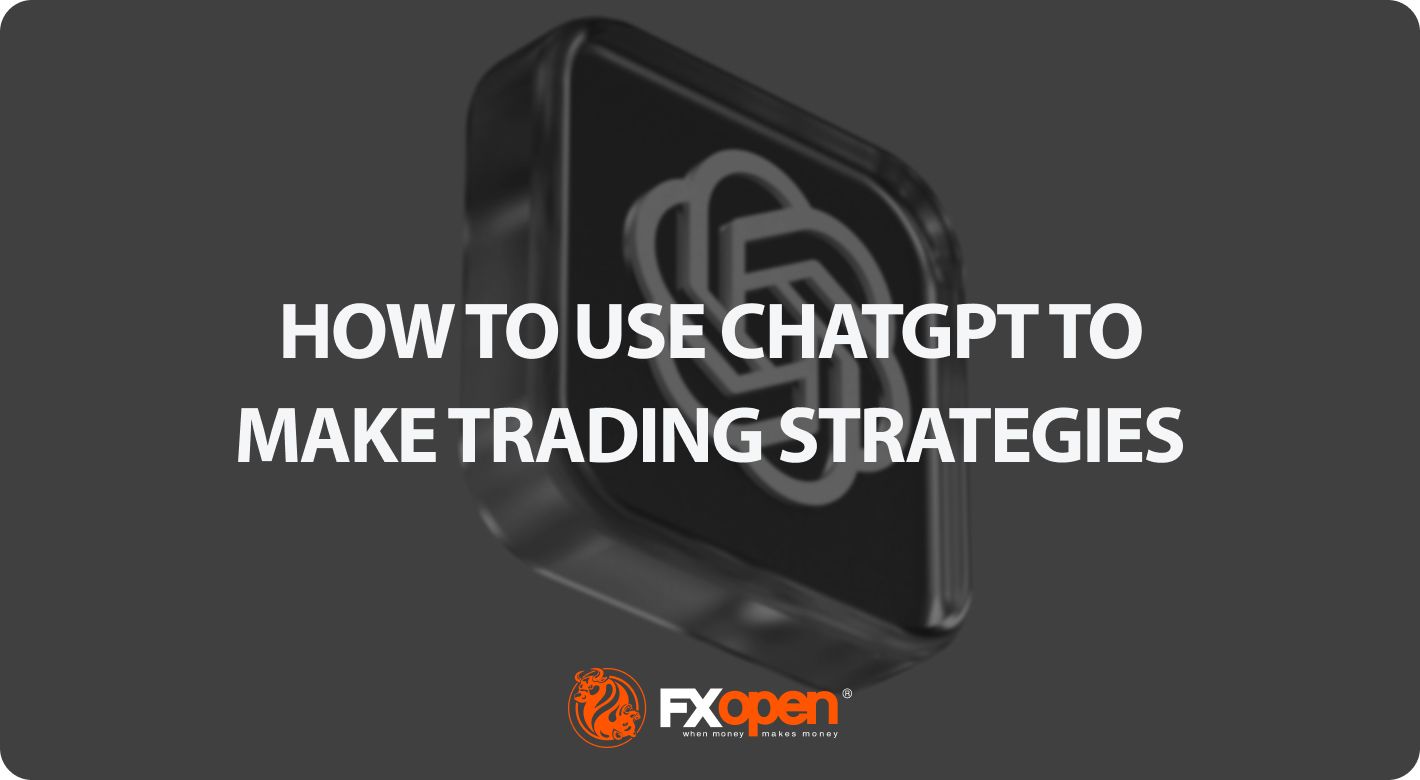FXOpen

Using ChatGPT to trade stocks, forex pairs, and commodities has become a hot topic in 2023. This article delves into how this advanced AI model can assist traders in crafting both manual and algorithmic trading strategies. Covering the fundamentals of ChatGPT, requirements, and a step-by-step outline, we provide an informative, accessible road map for traders interested in leveraging this nascent technology.
The Fundamentals of ChatGPT
ChatGPT, or Chat Generative Pre-trained Transformer, is a cutting-edge machine learning model designed for natural language processing tasks. Developed by OpenAI, it has been trained on vast datasets to understand, analyse, and generate human-like text based on the inputs it receives. Although it has applications ranging from customer service to content creation, its potential in the realm of trading is still being fully explored.
A noteworthy point is the distinction between GPT-3.5 and GPT-4, the latest iteration. GPT-4 offers several improvements over its predecessor, including more training data, better contextual understanding, and enhanced performance.
These upgrades make GPT-4 not only more accurate but also more efficient in tasks requiring complex data analysis, like trading strategy development. Although GPT-4 is only available with a paid subscription, it may be a worthy investment if you’re looking to use ChatGPT for trading.
How to Create Manual ChatGPT Trading Strategies
To begin trading with ChatGPT, you'll need a few essentials:
- ChatGPT Plus Subscription: Ideally, subscribe to ChatGPT Plus for access to the enhanced GPT-4 model. A free account can also serve the purpose but may lack some advanced capabilities.
- Knowledge of Trading and Indicators: An existing understanding of trading concepts and indicators is crucial. This not only helps you comprehend why a given strategy might work but also enables you to fine-tune it.
- Trading Platform: A trading platform like FXOpen's TickTrader is necessary to test and apply your trading strategies.
Idea Generation
We start by asking ChatGPT to generate a list of strategies. The more specific your query, the better the output. For instance, you might ask, "Generate a list of 5 trading strategies that incorporate the Relative Strength Index (RSI) and have a high win rate," or "Generate 5 momentum-based trading strategies with specific entry and exit criteria to use on a 15-minute timeframe."
Evaluate Strategies
Once you have a list, you can evaluate the potential of these strategies. Apply them to historical data on your charts to gauge their effectiveness. Alternatively, if any strategies immediately grab your attention, flag those for deeper exploration. The aim is to identify a strategy that holds promise, at least theoretically.
Refinement
If you have a strategy that looks good on paper, we could ask ChatGPT for more specifics about the strategy and ways to improve it. For example, if you're using ChatGPT for forex trading and want to fine-tune your stop-loss settings, ChatGPT can offer advice. Keep iterating based on this feedback, understanding the strategy's limitations and refining it until you're satisfied. Aim to have a strategy that covers entries and exits, risk management and any additional confluence factors that might add confirmation.
Backtesting and Forward Testing
The final step is backtesting the strategy to ensure its viability. This can be done manually by analysing past data on charts or algorithmically, which will be discussed in the next section. Once the strategy is profitable in backtesting, we can begin to forward test in live markets.
How to Use ChatGPT for Algo Trading
To create an algorithmic ChatGPT trading script, some additional requirements come into play:
- Previous Requirements: The same prerequisites for manual trading apply here — ideally, a ChatGPT Plus subscription, trading knowledge, and trading platform.
- Programming Knowledge: Familiarity with a trading-specific programming language is essential. For this example, we'll consider TradingView's PineScript, though Python or MQL5 are valid alternatives.
- Implementation Tools: The necessary software and hardware to run your trading script.
- Data Source: Access to quality data for backtesting is crucial.
Idea Generation
As with manual strategies, the first step is to generate ideas. Ask ChatGPT for trading strategies based on your criteria, like "Provide specific high risk/reward forex trading strategies that are optimised for low-volatility environments."
Create the Strategy’s Code
After identifying a promising approach, request ChatGPT to flesh out a complete trading strategy in your chosen programming language. ChatGPT can generate the necessary code for entry, exit, and risk management.
Backtesting and Simulation
Copy the generated code into your trading software and employ its backtesting functions to evaluate the strategy's effectiveness. Alternatively, Plus subscribers can upload historical data using the Code Interpreter feature in ChatGPT. The model will run a simulation and return performance metrics right within the chat.
Refinement
Finally, based on the backtesting results, ask ChatGPT how to refine the strategy further. If there are specific aspects that need improvement—be it entry criteria or risk management—ChatGPT can provide new lines of code to replace the existing parameters in your algorithm.
The Bottom Line
Utilising ChatGPT for trading strategy development offers a unique blend of technological innovation and trading acumen. Whether you're manually trading or using algorithmic methods, this tool can serve as an invaluable resource for generating, evaluating, and refining strategies. To take the experience to the next level, consider opening an FXOpen account for seamless strategy application across over 600 markets. Good luck!
This article represents the opinion of the Companies operating under the FXOpen brand only. It is not to be construed as an offer, solicitation, or recommendation with respect to products and services provided by the Companies operating under the FXOpen brand, nor is it to be considered financial advice.
Stay ahead of the market!
Subscribe now to our mailing list and receive the latest market news and insights delivered directly to your inbox.








